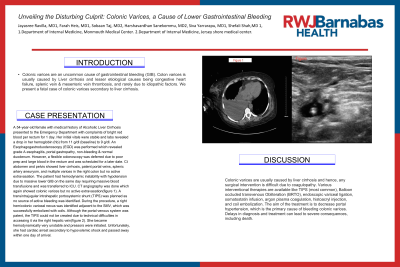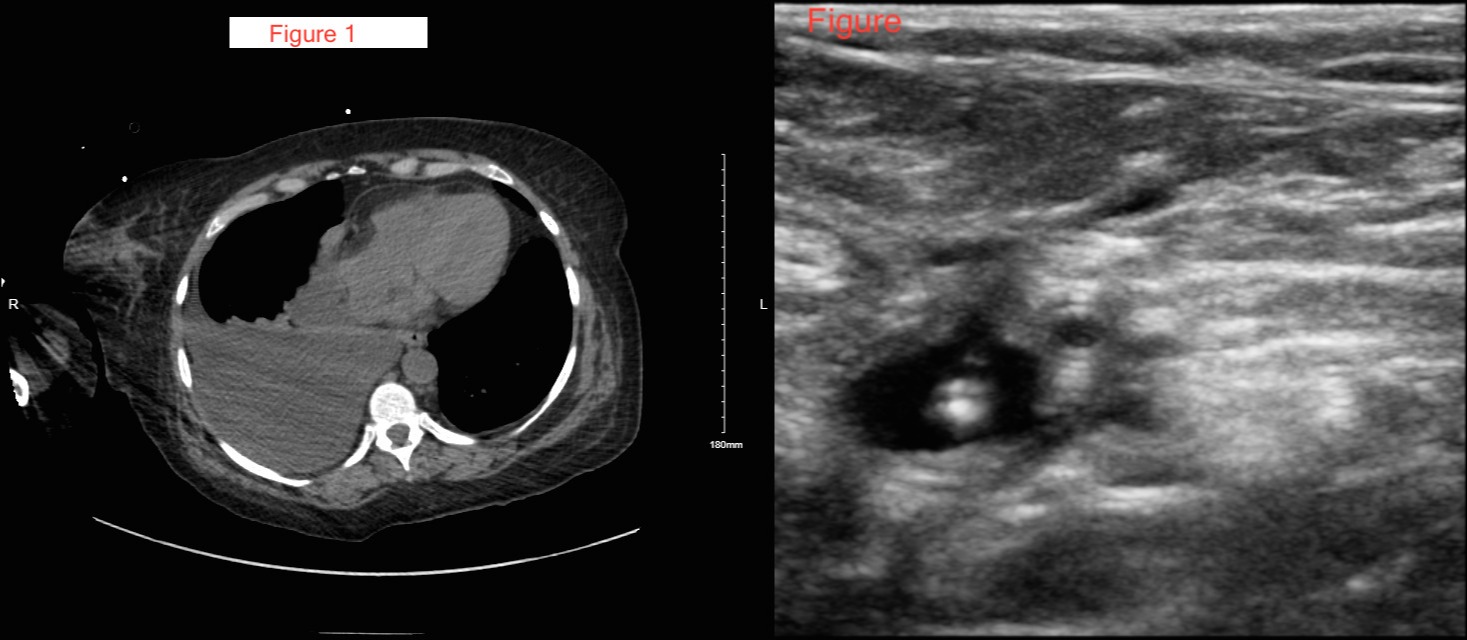Monday Poster Session
Category: GI Bleeding
P2067 - Unveiling the Disturbing Culprit: Colonic Varices, a Cause of Lower Gastrointestinal Bleeding
Monday, October 23, 2023
10:30 AM - 4:15 PM PT
Location: Exhibit Hall

Has Audio
- JR
Jayasree Ravilla, MD
Monmouth Medical Center/RWJBH
Long Branch, NJ
Presenting Author(s)
Jayasree Ravilla, MD1, Farah Heis, MD2, Sobaan Taj, MD3, Harshavardhan Sanekommu, MD3, Siva Naga Srinivas Yarrarapu, MD1, Shefali Shah, MD2
1Monmouth Medical Center/RWJBH, Long Branch, NJ; 2Monmouth Medical Center, Long Branch, NJ; 3Hackensack Meridian Jersey Shore University Medical Center, Neptune, NJ
Introduction: Colonic varices are an uncommon cause of gastrointestinal bleeding (GIB). Colon varices is usually caused by Liver cirrhosis and lesser etiological causes being congestive heart failure, splenic vein & mesenteric vein thrombosis, and rarely due to idiopathic factors. We present a fatal case of colonic varices secondary to liver cirrhosis.
Case Description/Methods: A 54-year-old female with medical history of Alcoholic Liver Cirrhosis presented to the Emergency Department with complaints of bright red blood per rectum for 1 day. Her initial vitals were stable and labs revealed a drop in her hemoglobin (hb) from 11 g/dl (baseline) to 9 g/dl. An Esophagogastroduodenoscopy (EGD) was performed which revealed grade A esophagitis, portal gastropathy, non-bleeding & normal duodenum. However, a flexible colonoscopy was deferred due to poor prep and large blood in the rectum and was scheduled for a later date. Ct abdomen and pelvis showed liver cirrhosis, patent portal veins, splenic artery aneurysm, and multiple varices in the right colon but no active extravasation. The patient had hemodynamic instability with hypotension due to massive lower GIB on the same day requiring massive blood transfusions and was transferred to ICU. CT angiography was done which again showed colonic varices but no active extravasation(figure 1). A transintrajugular intrahepatic portosystemic shunt (TIPS) was planned as no source of active bleeding was identified. During the procedure, a right hemicolonic variceal nexus was identified adjacent to the SMV, which was successfully embolized with coils. Although the portal venous system was patent, the TIPS could not be created due to technical difficulties in accessing it via the right hepatic vein(figure 2). She became hemodynamically very unstable and pressors were initiated. Unfortunately, she had cardiac arrest secondary to hypovolemic shock and passed away within one day of arrival.
Discussion: Colonic varices are usually caused by liver cirrhosis and hence, any surgical intervention is difficult due to coagulopathy. Various interventional therapies are available like TIPS (most common), Balloon occluded transvenous Obliteration (BRTO), endoscopic variceal ligation, somatostatin infusion, argon plasma coagulation, histoacryl injection, and coil embolization. The aim of the treatment is to decrease portal hypertension, which is the primary cause of bleeding colonic varices. Delays in diagnosis and treatment can lead to severe consequences, including death.

Disclosures:
Jayasree Ravilla, MD1, Farah Heis, MD2, Sobaan Taj, MD3, Harshavardhan Sanekommu, MD3, Siva Naga Srinivas Yarrarapu, MD1, Shefali Shah, MD2. P2067 - Unveiling the Disturbing Culprit: Colonic Varices, a Cause of Lower Gastrointestinal Bleeding, ACG 2023 Annual Scientific Meeting Abstracts. Vancouver, BC, Canada: American College of Gastroenterology.
1Monmouth Medical Center/RWJBH, Long Branch, NJ; 2Monmouth Medical Center, Long Branch, NJ; 3Hackensack Meridian Jersey Shore University Medical Center, Neptune, NJ
Introduction: Colonic varices are an uncommon cause of gastrointestinal bleeding (GIB). Colon varices is usually caused by Liver cirrhosis and lesser etiological causes being congestive heart failure, splenic vein & mesenteric vein thrombosis, and rarely due to idiopathic factors. We present a fatal case of colonic varices secondary to liver cirrhosis.
Case Description/Methods: A 54-year-old female with medical history of Alcoholic Liver Cirrhosis presented to the Emergency Department with complaints of bright red blood per rectum for 1 day. Her initial vitals were stable and labs revealed a drop in her hemoglobin (hb) from 11 g/dl (baseline) to 9 g/dl. An Esophagogastroduodenoscopy (EGD) was performed which revealed grade A esophagitis, portal gastropathy, non-bleeding & normal duodenum. However, a flexible colonoscopy was deferred due to poor prep and large blood in the rectum and was scheduled for a later date. Ct abdomen and pelvis showed liver cirrhosis, patent portal veins, splenic artery aneurysm, and multiple varices in the right colon but no active extravasation. The patient had hemodynamic instability with hypotension due to massive lower GIB on the same day requiring massive blood transfusions and was transferred to ICU. CT angiography was done which again showed colonic varices but no active extravasation(figure 1). A transintrajugular intrahepatic portosystemic shunt (TIPS) was planned as no source of active bleeding was identified. During the procedure, a right hemicolonic variceal nexus was identified adjacent to the SMV, which was successfully embolized with coils. Although the portal venous system was patent, the TIPS could not be created due to technical difficulties in accessing it via the right hepatic vein(figure 2). She became hemodynamically very unstable and pressors were initiated. Unfortunately, she had cardiac arrest secondary to hypovolemic shock and passed away within one day of arrival.
Discussion: Colonic varices are usually caused by liver cirrhosis and hence, any surgical intervention is difficult due to coagulopathy. Various interventional therapies are available like TIPS (most common), Balloon occluded transvenous Obliteration (BRTO), endoscopic variceal ligation, somatostatin infusion, argon plasma coagulation, histoacryl injection, and coil embolization. The aim of the treatment is to decrease portal hypertension, which is the primary cause of bleeding colonic varices. Delays in diagnosis and treatment can lead to severe consequences, including death.

Figure: Figure 1 demonstrates right colonic varices without extravasation, figure 2 shows coil embolization unto portal vein;attempted failed TIPS
Disclosures:
Jayasree Ravilla indicated no relevant financial relationships.
Farah Heis indicated no relevant financial relationships.
Sobaan Taj indicated no relevant financial relationships.
Harshavardhan Sanekommu indicated no relevant financial relationships.
Siva Naga Srinivas Yarrarapu indicated no relevant financial relationships.
Shefali Shah indicated no relevant financial relationships.
Jayasree Ravilla, MD1, Farah Heis, MD2, Sobaan Taj, MD3, Harshavardhan Sanekommu, MD3, Siva Naga Srinivas Yarrarapu, MD1, Shefali Shah, MD2. P2067 - Unveiling the Disturbing Culprit: Colonic Varices, a Cause of Lower Gastrointestinal Bleeding, ACG 2023 Annual Scientific Meeting Abstracts. Vancouver, BC, Canada: American College of Gastroenterology.
